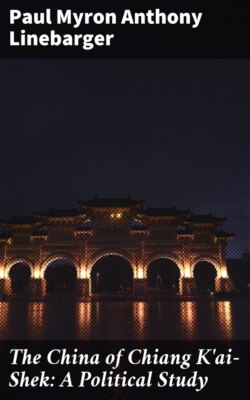Читать книгу The China of Chiang K'ai-Shek: A Political Study - Paul Myron Anthony Linebarger - Страница 6
На сайте Литреса книга снята с продажи.
The Beginning of Active Hostilities
ОглавлениеTable of Contents
After nearly six years of military and political conflict, a full quasi-war[7] broke out with the episode at Loukouchiao on the night of July 7–8, 1937. It was the evident intention of the Japanese to end an unsatisfactory state of affairs (i.e., Chinese control) in that area once and for all, although they were perfectly willing to express temporary amity and ad interim non-aggression toward what was left of China. The National Government, after a few days of uncertainty, began real preparations for war. Since the government's appeasement policy had accustomed many to think of resistance in terms of the Left, there was an enormous inflation of Leftist sentiment, not deflated for about eighteen months.
While new mass organizations were formed, the Chinese military command framed a plan for a three-stage war:
(1) a period of resistance by heavy regular forces fighting positionally;
(2) a period of stalemate wherein enemy forces, immobilized by opposing regular armies, found lines of communication, supplies and business harassed by guerrillas and saboteurs;
(3) a period of counter-attack in which the Chinese, having prepared themselves technologically during the stalemate and having weakened the enemy by a test of endurance, should drive the Japanese back into the sea.
The strategy of this type of war was based upon the plan of retreating in space in order to advance in time—that is, to yield area slowly and purposefully, without too great cost to oneself, in order to outlast the enemy and reach victory. In thus purchasing time by the mile, the Chinese could not afford to yield intact cities, factories, communications, mines, docks, warehouses and the other goods of business; such cessions would only profit Japan: hence the scorched earth policy. The strategy was obviously suited to a country rich in territory and population, but poor in matériel. It not only made both regulars and guerrillas effective against Japan but made each truly reliant upon the other. Without the Nationalist regular armies, who in attempting to suppress the Communists had done almost everything which the Japanese now had to do—guarding railroads, pacifying disaffected and hostile rural areas, promoting industries and watching agitation—the Japanese forces might disperse enough to enable Japan to patrol and pacify enough of China to pay for the occupation. Chiang had to hold the Japanese together, immobilize large bodies of their troops, keep their war expenses up, and wait for the time to counter-attack. Meanwhile the guerrillas, together with the Communist veterans, were to prevent the Japanese from settling down, to worry them with agitation, to sabotage their economic efforts and to wear them out for Chiang's révanche.
One of the first governmental changes in wartime was the re-institution of an effective propaganda service under the Political Department of the Military Affairs Commission. In this Department, many of China's most active controversialists, censored or exiled for years, found officially sanctioned scope for their energies. Formal unity came slowly. Although Shanghai was attacked on August 13, 1937, it was not until September 10 following that a fairly definitive arrangement was reached in regard to the Communist-occupied zone in the Northwest.
The settlement transformed a pre-existing armistice into an intranational alliance; technically it amounted to submission by the Communists and their incorporation into the national government and armies. The area of the Chinese Soviet Republic assumed the name Special Regional Government of the Chinese Republic (Chunghua Min-kuo T'ê-ch'ü Chêng-fu), which it had been using informally for months; the Chinese Red Army became the Eighth Route Army (Pa-lu-chün); and the Chinese Communist Party accepted the San Min Chu I as the constitutional state ideology of China, abandoning immediate measures of class war and expropriation. The settlement was in the form of a Communist reply to Kuomintang terms offered in February 1937 and the reply of the Generalissimo as Chief of the Kuomintang to the Communist declaration.[8]
For the first few months the war kept its quasi-European pattern. The greater part of the fighting was done in the Shanghai area, while Japanese forces proceeded down from North China. The Japanese still had some expectation of localizing the North China and the Shanghai conflicts. At most, they expected the war to be a short one, not extending beyond the capture of Nanking. Occupation of the capital was counted on for the ruin of the central government, the end of Chiang and the reversion of China to a condition of malleable anarchy.
December 1937 was the blackest month of the war for the Chinese. The Japanese advanced toward Nanking, with Chinese resistance crumbling; part of the armies withdrew in good order, but on occasion there were hopeless, panicky routs. To this month the Japanese looked for victory, and were so confident that they formed the pro-Japanese Provisional Government of the Republic of China, in Peking on December 11.[9] Four days later the Japanese forces entered Nanking, and the ensuing fortnight set the record for atrocity in the modern world. The Japanese forces were preoccupied with their own disorder. The National Government escaped up-river to Hankow, where it promptly began to function under the three-headquarters plan: some offices at Hankow, some at Changsha and some at Chungking. The presence of the foreign affairs, propaganda, and military agencies at Hankow made this the practical capital of China, although Nanking was and is the constitutional capital.
